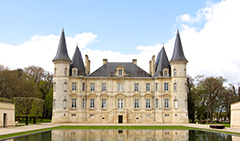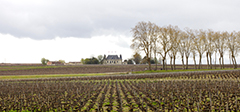Bordeaux 2017

Chateau Lafleur presents itself better than most, which is also the case in 2017.

The beautiful, iconic Chateau Pichon Baron in Pauillac.

Chateau Palmer seen from Chateau Margaux.
What They Talked About ...
Let it be said straight away, everyone talked about the spring frost of 2017.
The frost on the 26-27 April was by far the greatest villain of the vintage for some, while for others the frost was simply a hot conversation topic. This year's devastation is being compared to 1991, where a late spring frost also hit the region.
Overall, the frost has taken about 40% of the 2017 harvest, where the biggest losses were in Saint-Emilion, Pomerol and the satellite municipalities around this area. Margaux, Listrac, Moulis and Pessac-Leognan were also hard hit.
In other words, the frost struck in many places. However, the vineyards of Saint-Estephe, Pauillac and Saint-Julien – the municipalities closest to the river – went largely untouched.
In many places, the locals fought the frost with countless bonfires scattered around the vineyards. Others used a combination of fire and small windmills to keep the air circulating, thereby preventing the ice-cold air from reaching the plants. Water sprayed across the vineyards by either helicopter or sprinklers was another way to fight the frost.
On its own, the reduced harvest is an economic problem, but the lost fruit from certain parcels makes it difficult to mix as good a wine as produced in other vintages that did not suffer from frost. The result might, therefore, be felt in the taste – some places more than others.
What All This Means ...
The quality of the harvest is at a fairly good level, for some individual wines it is very high, but in a broader perspective, the vintage is a bit below the level achieved in the past two years. Several winemakers talked about a quality lying between 2014 and 2015, closest to the latter. Overall, I do not believe the vintage can rise above 2014 for the red wines. They lack length, nerve and in many cases maturation. However, I would enjoy seeing many of the smaller wines and the larger chateaux’ second wines find their way to the restaurants’ wine list within a short period of time. The wines appear immensely welcoming, fragrant and, not least, tasty. The wines from the district are too expensive for most restaurant customers, so the area's smaller wines will be able to win over some fans as these will be sold at a significantly cheaper price.
The White Wines
The white wines in 2017, on the other hand, are a chapter all of their own. They have had a long enough maturation process with cool nights. This has provided some fresh, aromatic grapes with a high acidity and not too high a level of alcohol. The best of the wines will easily last for 40-50 years, while the lesser ones will be extremely delicate in their youth as well as have a considerable storage potential.
Something for Your Sweet Tooth
The few sweet wines I tasted were at an absolute top level. Aromatic and with a refreshing acidity and a good portion of residual sugar. The quality here seems to be top-notch.
The Story of 2017
Each year has its own story, and in the history books, 2017 will be remembered for the frost, which was also the case with 1991. However, many beautiful wines came out of 1991, and this will also be the case for 2017. Some of the winemakers have achieved extraordinary results while others weren’t able to harvest anything and suffered significant losses.
My conclusion to the efforts of the primeur week is that many of the wines had a fine taste, a few impressed, while a great deal will soon be forgotten.
Many of the chateaux have come out with prices that are 10-20% lower than last year's prices. With this level in the pricing, it is hard to see any reason to buy the wines now when the 2014 vintage is still cheaper to purchase. However, there are some wines that distinguish themselves and are definitely worth investing in, such as Lafleur, Vieux Chateau Certan, L'Eglise-Clinet, Nenin, and the white wines of Pessac-Leognan with the white Cos d'Estournel as a joker in that game.
My top ten after the tasting on 9-12 April 2018
-
Chateau Lafleur: 95-96 point
-
Vieux Chateau Certan: 94-96
-
L’Eglise Clinet: 94-96
-
Latour: 94-96
-
Haut Brion Blanc: 94-95
-
Haut Brion: 93-95
-
Mouton Rothschild: 93-95
-
La Mission Haut Brion Blanc: 93-95
-
Petrus: 93-94
-
La Mission Haut Brion: 93-94
Dive into the details of the individual wines here
For further information, please contact:
Anders Gudmundsson: +45 8818 1205 · ag@bruun-rasmussen.dk
Morten Stenør Larsen: +45 8818 1207 · msl@bruun-rasmussen.dk
Henrik Christensen: +45 8818 1241 · hch@bruun-rasmussen.dk
Thomas Rosendahl Andersen: +45 8818 1206 · tra@bruun-rasmussen.dk